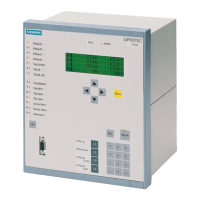'(& )( )'& &) ( &!& ")& &$(( $# Ć %&( $# #)" &&#$
6 - 56
Siemens AG ⋅ May 1998
The following two criteria are important for the selecĆ
tion of k:
1. Type of current transformer - linear or convenĆ
tional..
CTs with closed iron cores transmit the DC comĆ
ponent with little reduction. Linearized CTs, howĆ
ever, reduce the DC component considerably.
2. The burden factor k
0F
of the current transformers.
This factor is calculated from the maximum continĆ
uous short-circuit current
sc
and that current
s
at
which CT saturation starts:
k
0F
=
sc
/
s
The saturation current
s
is derived from the rated
current
N
and the operational overcurrent number
n'.
s
=
N
.
n`
Operational overcurrent number results from the
CT data and the actual burden of the current transĆ
former.
n`= (P
n
+P
i
)
.
n/(P
b
+P
i
)
P
n
= rated CT burden
P
b
= connected burden (protection + leads +
intermediate CT if applicable)
P
i
= internal burden of main current transformer
The k factor to be set is then:
k>k
0F
/4Ăk
0F
-1
The basis for this formula is summarized in appenĆ
dix A.1.3.
When choosing k, the largest burden factor k
0F
of
all the CTs in the outgoing feeders from the busbar
must be considered.
d) Response to diff-supervision
( )
Setting possibilities: "alarm only", "block with auĆ
tomatic release" or "block with storage"
Recommended setting: "alarm only"
The corresponding busbar can be selected via the
bus-related differential current supervision
"block". The check zone supervision should be
parameterized for "alarm only", so that blocking of
the complete protection is avoided.

